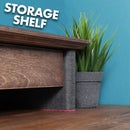Introduction: Fold Down Table - to Save Workshop Space
I have a very small workshop. Something I'm lacking is both floor space and usable table space. So a fold down table should give me the best of both worlds.
I have a video showing the process here:
Materials Used:
- 89mm CLS Timber
- 18mm Plywood
- Lift Off Hinges
- Butt Hinges
- Screws
Tools Used:
- Magnet Driver Bits
Get 10% off at Amazon with the code: JOEJOINERY
Get 15% off at Micaton with the code: JOEJOINERY
- Table Saw
- Mitre Saw
- Drill & Driver
- Jigsaw
Step 1: Cut CLS to Size
I already had some 89mm wide CLS timber so I decided to rip it in half on the table saw. It not only makes the structure slimmer but it also gives me double the material to work with.
I've created a cut list if you would like to make a table to the same dimensions.
With the pieces ripped in half I could cut them to length on the mitre saw.
Step 2: Construct the Table
The joinery will be simple butt joints, screwed together.
I added 3 supports in the middle to help prevent the plywood top from sagging in the middle.
I cut some 18mm plywood to match the size of the frame and attached it to the frame with screws.
The leg construction is really simple. It consists of 1 x 40cm piece, which will attach to the wall with hinges.
2 x 36cm pieces and 1 x 79cm piece which is the leg support. Again, these are screwed together with butt joints and the corners are supported by some 18mm plywood. Its surprising how well adding plywood to the corners helps to stiffen up the whole structure.
Step 3: Add Hinges & Mount to the Wall
Because my shed floor isnt flat or even close to level I opted to use lift off hinges. These will allow me to lift the legs over the bumps in the floor when I open them and fold them away.
The table top itself just gets 3 butt hinges along the back. I made sure the barrel of the hinges was flush with the top.
Attaching the legs to the wall is nice and easy but attaching the table top to the wall on your own is more difficult.
This is where the magnet driver bits come into their own. Holding the table top against the wall and driving in the screws is very difficult on your own. Ideally having someone to help you would be the best bet. However, using the magnet driver bits made it really easy to do. I could just click the screws onto the bit and drive them in place. brilliant!
Step 4: Add Latch & Done!
I made a simple catch to stop the table top from falling down. Its just a block of wood with a hole in it. An old allen key does the job of holding the table in place.
That's the table done. Its very simple but it does the job. I have managed to give myself more table space while still keeping my much need floor space.

Participated in the
Woodworking Contest













